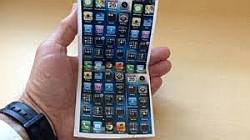Do NOT follow this link or you will be banned from the site!
A Look Into The Not Too Distant Future
Submitted by thedosmann on Sun, 05/10/2015 - 13:14
What is this strange device?
Edit 2/21/19: Samsung announces new foldable tablet/phone
https://www.samsung.com/us/mobile/galaxy-fold/
Within the next few years, we will see an exponential growth in micro touch screen devices that can be unfolded from 3x6 to 12x6 (and other sizes) to form a touch screen. These

devices will have no hard drive, no CD/DVD, no memory other than an ultra-thin EPROM, and no external ports. The EPROM will have a Linux flavor distribution on it that will get
you connected to your cloud space automatically. The keyboard, initially, will be a virtual keyboard much like that on a smart cell phone. The power supply will be a thin organic battery with a 3 hours use and 9 hours of standby time and super fast recharge rate. The device will feature front and back facing cameras and super hi-definition flexible speakers built in. It will also contain Wi-Fi and Bluetooth technology.
When you power the unit on the device will automatically search for the nearest Wi-Fi or Bluetooth connection and connect to your cloud.
Your cloud space is an executive level package that includes your operating system and a select set of programs that came with the executive level package. Of course, you had to agree to a 3-year contract for the service but your cool connection device made it worth the commitment. Also, you don’t have to pay for a cell phone now because it’s built into the connection device. That’s right, when folded up your device is a cell phone and when unfolded is both a cell phone and a way to connect to your cloud.
The fluffy clouds of technology
Your cloud will include your operating system of choice, browser(s) of choice, email client(s), production applications, business applications, social applications, and any other programs/games you decide to install to your cloud. You don’t have to worry about viruses because all your applications and your OS are in the cloud and are covered under your service agreement against viruses and hacking threats. You won't lose any documents or information because all your files are backed up real time. If you decide you need another application you just add it to your cloud. Most of them are free, but you may have to put up with some advertising breaks while using the application or you can just purchase the program free of advertising.
While all this technology advancement is being made keep in mind that just because the programs are in the clouds the programmer is not god and the help desk is not an angel. There are still going to be user issues and programming glitches. The amount will be cut drastically because now everything is in a controlled environment. The virus problem will become a non-issue at some point. Instead of hackers having millions of computers to hack they will have to adapt to trying to hack hardened IaaS, SaaS, and PaaS sites.
Writing on the clouds
From a programming point of view, this is actually a major plus. All the programming will be done in the clouds. Because the OS is in the clouds programming can be trimmed done to not include the mechanics and physics of the device. All of the processing will be done in the cloud, including data storage and retrieval. The connection device will act like a thin client and will not be constrained by processor or memory concerns. All we are sending is display data from the cloud so the device video will be the only concern. Different models will be more capable than others in displaying video in certain aspect ratios. The video capabilities and the connection speed will be in the device manufacturer’s venue, not the programmer’s.
Not unlike cell phones, the connection devices will be available in various styles, colors, and sizes. There will also be several available features on different models. It is clear, according to the supporting links below, the technology is here. The main stumbling block to this and any other technology advance is acceptance and price. There will be segments of users who will just not accept the change for various reasons and price will also be a factor. In my experience, as the price gets right so will acceptance and wide use of the technology.
http://www.oled-info.com/samsung-develops-seamless-foldable-amoled
http://www.theverge.com/2012/3/12/2864092/0-3mm-thin-organic-radical-battery-nec-IC-card
http://www.engadget.com/2012/07/02/samsung-merges-s-lcd-and-mobile-display-units-under-samsung-disp/
http://en.wikipedia.org/wiki/Converged_infrastructure
http://en.wikipedia.org/wiki/Cloud_computing
Note: This article was originally written three years ago (2012) and since then technology has advanced to the point where we are seeing such devices being produced. According to recent articles, the manufacturing process has advanced to reduce cost and global demands for the technology have created opportunities in a number of technical fields.
There has also been a strong move toward centralized cloud platforms with thin client connections like the new Google Compute Engine and a number of growing company offerings for cloud connections.
We're still not at a commercially feasible smartphone that unfolds to a laptop but we are edging ever so closely.
The following sites offer up-to-date information.
http://www.androidauthority.com/sel-foldable-display-smartphone-545945
https://cloud.google.com/compute/
by Jim Atkins "thedosmann"
Sitetags:
Share it now!
